Posts Tagged ‘RAF’
The Spitfire: Birth of a British Aviation Icon

On March 5, 1936, the skies above Hampshire witnessed an event that would reshape the course of aviation and military history. From Eastleigh Aerodrome (now Southampton Airport), the prototype of the Supermarine Spitfire took flight for the very first time—ushering in a new era of fighter aircraft engineering. With its elegant design and formidable performance, the Spitfire would soon become a symbol of British resilience in the face of war.
The Iconic Sound
↓ Hear the iconic sound of a Spitfire fly past. Click Play Below ↓
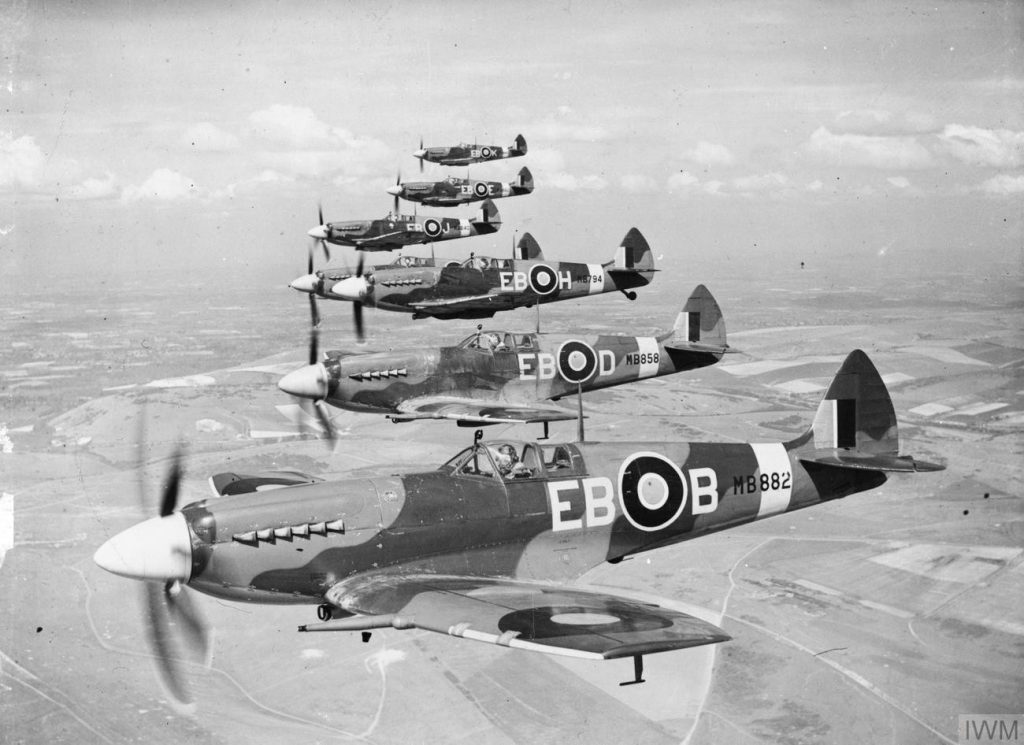
A Revolutionary Aircraft Takes Flight
The Spitfire was the masterpiece of Reginald J. Mitchell, the chief designer at Supermarine Aviation Works, part of Vickers-Armstrongs. Drawing from his experience designing high-speed racing seaplanes for the Schneider Trophy, Mitchell applied the same aerodynamic brilliance to the creation of a revolutionary monoplane fighter.
Did You Know? The Spitfire’s elliptical wing design wasn’t just stylish—it reduced drag and improved lift, giving the aircraft a tighter turning radius and better performance at high speeds than many of its contemporaries.
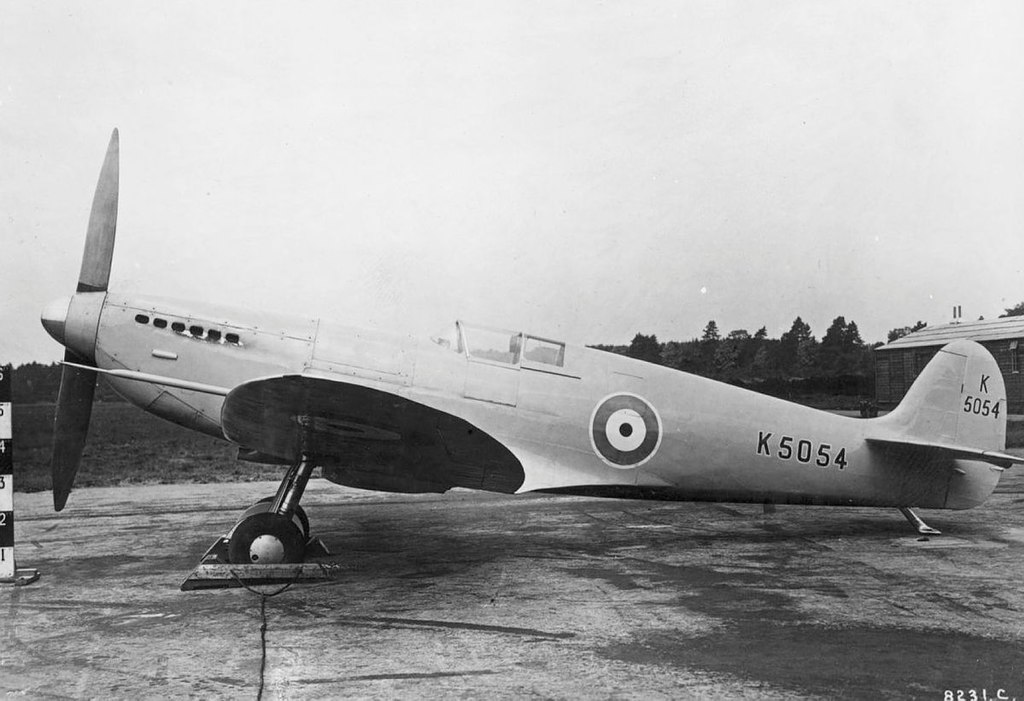
On that historic afternoon, test pilot Captain Joseph “Mutt” Summers climbed into the cockpit of prototype K5054. The aircraft, powered by the Rolls-Royce Merlin engine, performed so well during the short eight-minute maiden flight that Summers famously declared, “I don’t want anything touched!“
From Prototype to Production
The promising performance of the Spitfire’s first flight quickly caught the attention of the British Air Ministry. Just three months later, on June 3, 1936, an order for 310 Spitfires was placed, beginning what would become one of the most celebrated production runs in military aviation.
↑ Click the circles 🔴 in the image above to find out more about each part of the Spitfires Design. ↑
Did You Know? Over 20,000 Spitfires were built between 1936 and 1948, making it the most produced British fighter aircraft of World War II.
Despite early production challenges, the first units reached RAF squadrons by 1938, positioning the Spitfire as a critical asset just as tensions in Europe escalated.
Defender of Britain’s Skies
The Battle of Britain in 1940 cemented the Spitfire’s place in legend. While the Hawker Hurricane bore the brunt of the fighting, the Spitfire was instrumental in duels with the Messerschmitt Bf 109, Germany’s top-tier fighter. Its superior speed, rate of climb, and maneuverability made it a favourite among pilots and a feared opponent in the sky.
Did You Know? The Spitfire’s wings were so thin and strong that eight .303 Browning machine guns were housed within—an innovative feature at the time.
Its agility and speed became not only a tactical advantage but also a psychological one, bolstering the morale of Allied forces and the British public alike.
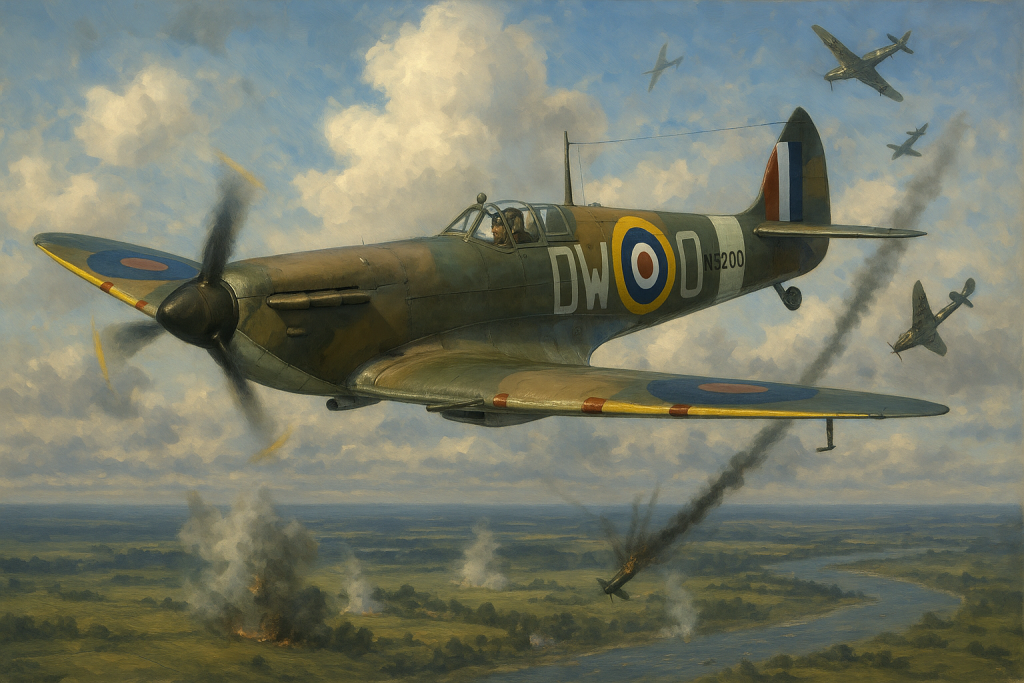
A Versatile and Evolving Design
The Spitfire was never a static design. Instead, it evolved through over 20 major variants, adapting to every phase of the war. As roles shifted, so did the aircraft: from interceptor to photo reconnaissance, from air superiority fighter to carrier-based Seafire.
Did You Know? Some Spitfires were specially equipped with cameras instead of guns and flew unarmed reconnaissance missions, providing vital intelligence over occupied Europe.
Later models even incorporated the Rolls-Royce Griffon engine, pushing the aircraft to greater altitudes and speeds.
The Legacy Lives On
Even decades after the guns fell silent, the Spitfire remains one of the most recognisable and admired aircraft in the world. Dozens of airworthy Spitfires still grace airshows and commemorative events, their distinctive Merlin engine roar still sending chills down the spine of all who hear it.

Did You Know? The name “Spitfire” was suggested by Sir Robert McLean, the then-chairman of Vickers, who reportedly described his spirited daughter as a “little spitfire.”
From wartime hero to timeless icon, the Spitfire continues to represent the innovation, courage, and determination of an era defined by conflict and triumph.
The Supermarine Spitfire’s first flight was more than a test—it was the beginning of a legend. Its combination of engineering brilliance, combat performance, and enduring symbolism has made it one of the most admired aircraft in history. From its role in defending Britain’s skies during World War II to its continued presence at airshows and in the hearts of aviation enthusiasts, the Spitfire is a testament to innovation and bravery.
Celebrate 85 Years Since the Battle of Britain

2025 marks the 85th anniversary of the Battle of Britain—a defining moment in British history where the Spitfire played a heroic role. To commemorate this significant milestone, we invite you to explore our exclusive range of Spitfire commemoratives, honouring both the aircraft and the brave pilots who flew them.
My Unforgettable Day with the Red Arrows
Written by Jonathan Patterson.
I’ve always been captivated by the Red Arrows, and the chance to see them up close at RAF Waddington was a dream come true.

Our day began in the early morning as we arrived at the base, passing through tight security checks with a sense of mounting excitement. We eagerly awaited our Red Arrows escort, who would take us to the heart of their operations.

As soon as we stepped off the Red Arrows mini-bus, the deafening roar of jet engines filled the air. We hurried to the viewing point only metres away from the runway, as the Red Arrows formed up and took off in a stunning, orchestrated formation.

For the next 20-30 minutes, the Red Arrows captivated us with their brand-new display for their 60th Diamond Season. Their daring barrel rolls, incredibly close manoeuvres, and crowd favourites like the Tornado left us in awe. The nine Hawk Jets flew overhead in an awe-inspiring sight, the thunderous noise was incredible. Starting with Red 1, each jet gracefully peeled away to land, marking the end of an unforgettable performance.

In need of a moment to absorb the experience, we decided to grab a cup of coffee. Within five minutes, a group of officers entered, with distinct marks around their ears from wearing some sort of helmets. It was then that I realised these were the Red Arrows pilots themselves, casually grabbing their coffees in their Red Arrows mugs. I was in complete awe of these men, who moments ago were hurtling through the clouds at over 500 mph.
Our RAF contact informed us that we only had a few minutes before debrief with the pilots. Led by Red One, Jon Bond, the meeting was a fascinating insight into their meticulous process. Each pilot critiqued their performance, highlighting areas for improvement and discussing how to perfect their manoeuvres for the next sortie that day. I was amazed to learn that the Red Arrows conduct these sorties and debriefs three times a day, every day, to ensure their displays are flawless and maintain their public display authority.

Next, we had the privilege of meeting and interviewing Red 10, Graeme Muscat. He shared insights about the Red Arrows, their intense manoeuvres, their strong focus on teamwork, and how they are a beacon for Great Britain, flying the red, white, and blue all over the world.
We were incredibly excited to show Graeme the brand-new 50p coins specially made to celebrate the 60th Diamond Season of the Red Arrows. His elation was clear as he smiled and said, “I think it’s amazing… I can keep that one, right?”
Our day with the Red Arrows was nothing short of extraordinary. From witnessing their breath-taking display to meeting the pilots and learning about their dedication, it was an experience that left us deeply inspired. The Red Arrows continue to be a symbol of excellence, teamwork, and pride for Great Britain.
To commemorate this special occasion, a brand-new coin range has been released to celebrate 60 years of the Red Arrows.

>>> Click here to explore the complete Red Arrows 60th Anniversary Diamond Season coin range <<<
The day I carried coins on board an Original WWII Lancaster
On 14th June, Ben, our Concept Development Manager, had the opportunity to see the famous RAF Avro Lancaster up close and personal.
Here’s what Ben has to say about his experience retracing the steps of the legendary Dambusters and having the brand new £5 coins carried on board an original WWII Lancaster Bomber…
To mark the 80th anniversary of Operation Chastise – the legendary Dambusters Raid, I wanted to capture some of that history and somehow apply it to some of the superb coins issued for the anniversary.
Following is my story of how our one day in Lincolnshire panned out. A story that makes each of these coins – in my opinion – uniquely collectable. Here’s how it went…
I have come to rural Lincolnshire to a private museum and airstrip at the Lincolnshire Aviation Heritage Centre in East Kirkby, to take some of the Dambusters 80th Anniversary Coins on a ride of a lifetime.
But before that happened, it was an overnighter in a remarkable hotel, few know about. This part of the English countryside is awash with airfields, aircraft museums and RAF bases.
It was central to RAF and Bomber Command’s missions and in 1944 the skies would have been buzzing with Spitfires, Hurricanes and of course, Lancaster Bombers. And that’s why the hotel I stayed in has some fascinating Dambusters links.
The Petwood Hotel was where Wing Commander Guy Gibson and the hand picked 617 Squadron had billeted during the war.
The squadron bar is now a museum shrine to the history of the squadron featuring artwork, photos and cabinets full of authentic 617 memorabilia. This is the exact room where Guy Gibson would have had a pint with his colleagues, as they discussed their missions past and present.
There is even a genuine prototype Bouncing Bomb in the garden…
It’s a remarkable feeling to know you’re sat at the very bar they did.
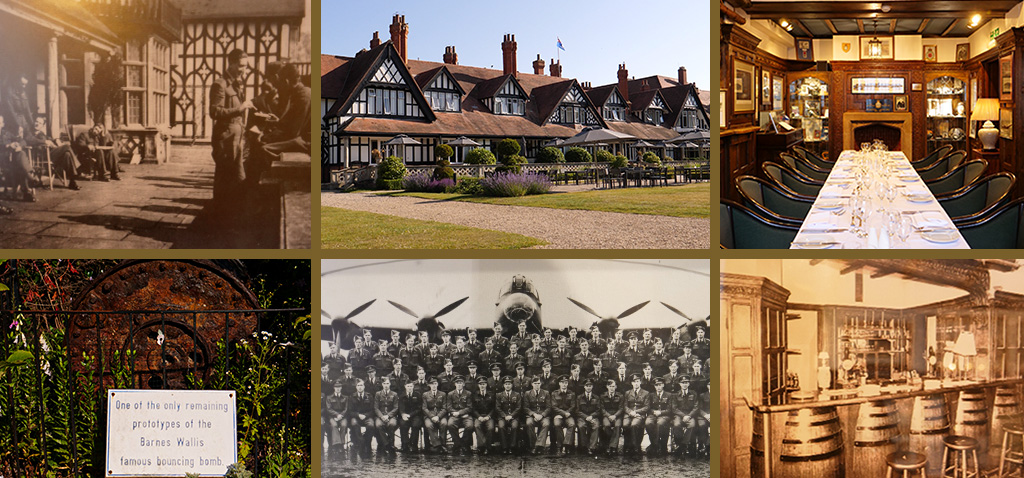
After an evening at the bar, it was up bright and early to head to the Lancaster Aviation Heritage Centre. And it was here as I drove through the gates, I got my first glimpse of ‘Just Jane’, one of only FOUR operational Lancaster bombers in the entire world.
Technically known as Avro Lancaster B. VII NX611, she was one of 150 Lancasters built in early 1945 for operations in the Far East.
She’s had a varied history. In the 1970s she stood as the Gate Guardian at RAF Scampton (home of Vulcan bombers and more recently, The Red Arrows) before being sold privately and moved to her current home in 1987. She is now a fantastic piece of aviation history, and the ongoing restoration program means hopefully soon we will see her take to the skies once more.
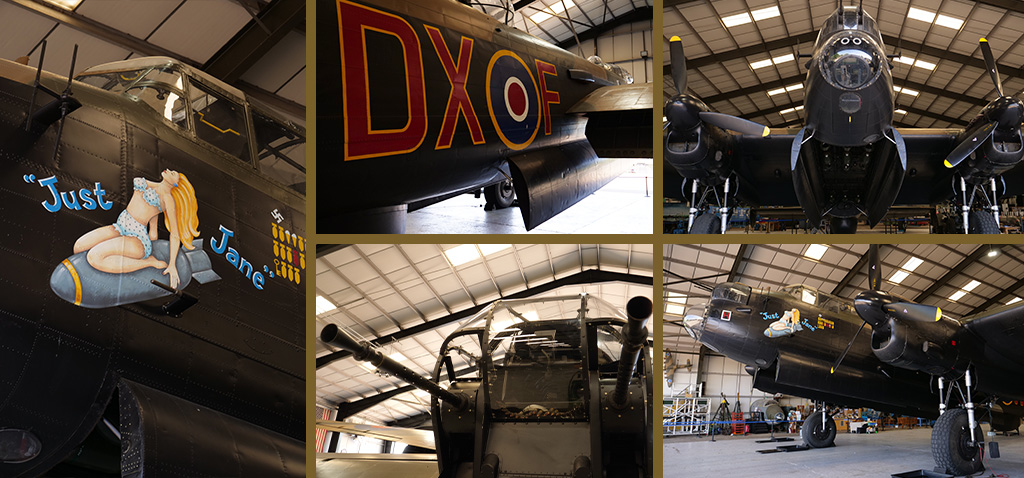
It was a beautiful sunny day, as I arrived at the airfield early in the morning to get the coins onboard. She was still in her hangar alongside the De Havilland Mosquito and a B25 Mitchell.
Before the Lanc was fired up – the main part of our mission started. We were given permission to board and get the coins securely stashed. This in itself was a privilege, reserved usually for visitors who book the tour and the ride, something that gets booked up a year in advance.
Despite its size, there is not a lot of room inside a Lancaster for boxes of coins!
There’s barely room for people, and only once you are inside do you contemplate how it must have felt when heading on a bombing mission. It’s dark, cramped, and once you are in position, there’s no moving. With the engines running I imagine it is exceptionally loud.
The coins were loaded in with help from the crew who work at the LAHC, and I had a short amount of time to photograph them inside the plane before she was moved outside and prepared for the day’s events.
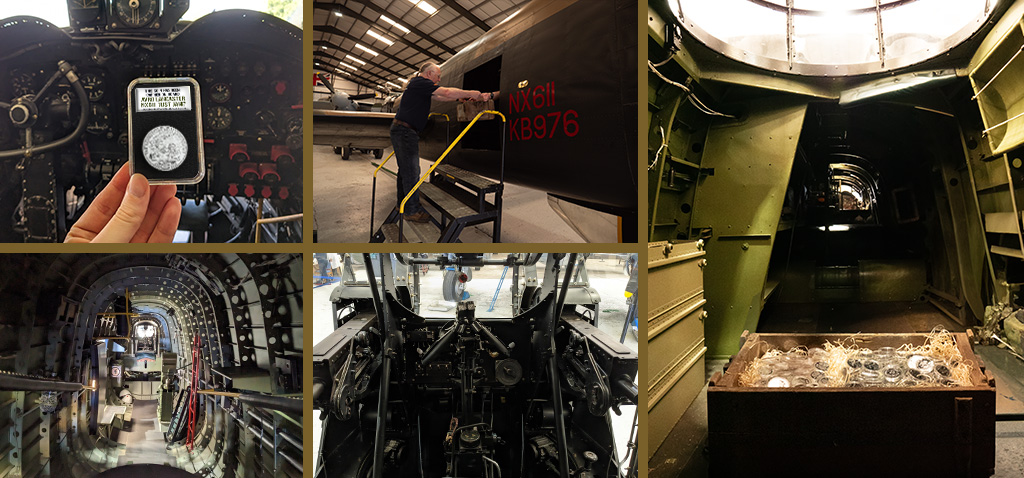
Then the magic happened.
As the four huge Merlin engines spluttered into life, a deafening roar bellowed across the tarmac, debris flew across the airfield as the wind seemed to pick up as we stood in awe. Lancaster Bomber NX611 made her way along the tarmac and onto the grass airstrip, where the engines kicked up a few notches.
It really is a sight to behold. And there we had it, coins travelling on board a piece of aviation history in the anniversary year of the Lancaster’s most famous moment – adding to their own provenance forever.
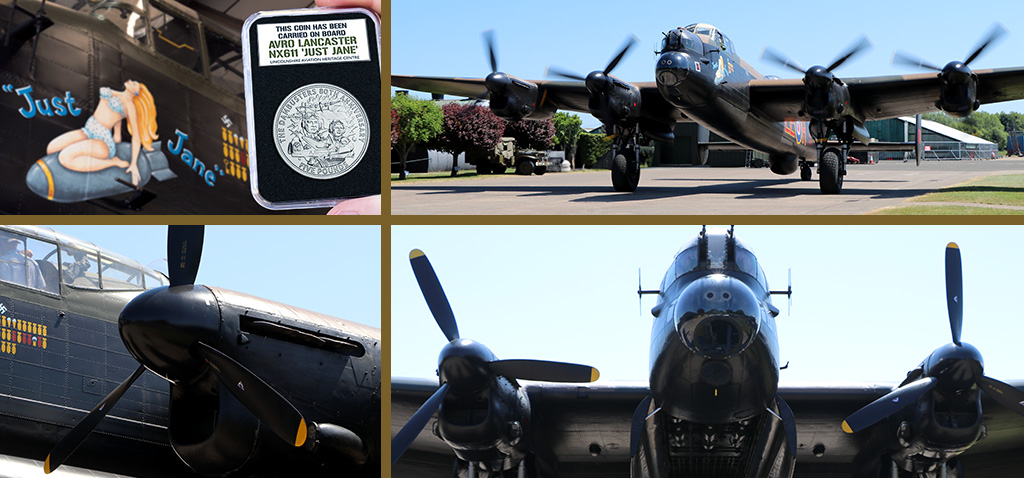
As the Lanc returned, the coins having been onboard a few hours, I had a five-minute window between runs to get onboard, remove the coins and stack them up on the airfield.
She had another group of guests to take for a ride. She wasn’t going to wait for us, and I wasn’t going to get in her way. It was a day I shall never forget. And thankfully, these coins now act as a lasting reminder of this epic and historic occasion.
If you’re interested…
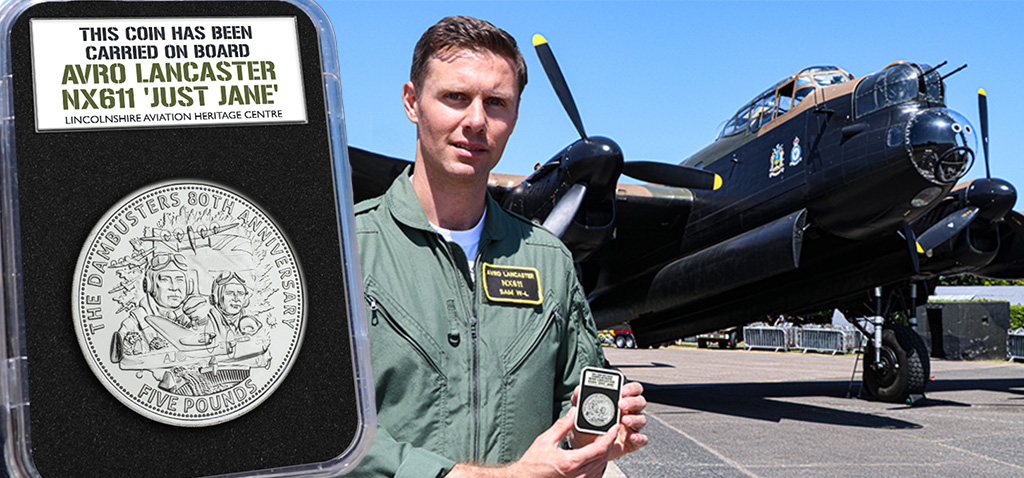
Click here to secure your Lancaster NX611 CARRIED Dambusters £5 for JUST £25 (+p&p) >>
